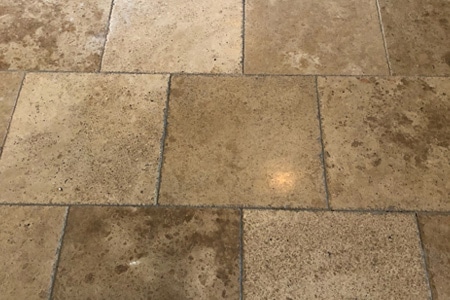Transform your dull, grimy slate tiles into gleaming masterpieces with this game-changing cleaning technique that professionals don’t want you to know.
Introduction
Slate tiles have long been celebrated for their natural beauty, durability, and timeless appeal in both modern and traditional homes. Yet, maintaining their lustrous appearance can be a challenging endeavor, especially when improper cleaning methods can lead to irreversible damage. Whether you’re a newlywed setting up your first home or a homeowner looking to revitalize your stone floor tiles, understanding the proper care of slate tiles is crucial. In this comprehensive guide, we’ll unveil professional-grade cleaning techniques that will help you maintain the beauty of your slate tiles for years to come.
Understanding Your Slate Tiles
Slate is a metamorphic rock composed primarily of clay minerals and micas, formed under intense pressure and heat over millions of years. This unique composition gives slate its distinctive layered structure and natural variations in color, ranging from deep charcoal to rich earth tones. Most slate tiles come in two main finishes: natural-cleft, which maintains the stone’s naturally textured surface, and honed, which offers a smoother, more uniform appearance. Unlike floor tiles, slate is naturally porous and can be more susceptible to staining and damage if not properly maintained. The material’s natural clefts and fissures, while adding character, can also trap dirt and debris, making thorough cleaning essential but challenging.
Common Cleaning Mistakes to Avoid
- Using Acidic Cleaners: Products containing vinegar, lemon, or other acidic substances can etch and permanently damage slate surfaces
- Applying Abrasive Tools: Steel wool, harsh scrub brushes, or abrasive pads can scratch and dull the surface
- Over-Wetting: Excessive water can seep into the porous material, leading to mineral deposits and potential damage
- Using Bleach-Based Products: These can discolor the stone and break down sealants
- Allowing Standing Water: This can lead to water spots, mineral deposits, and potential seepage issues
Real-world example: A homeowner used vinegar-based cleaning solution on their slate bathroom floor, resulting in permanent etching that required professional restoration costing over $2,000 to repair.
Essential Cleaning Tools and Products
- Cleaning Solutions:
- pH-neutral stone cleaner
- Mild dish soap (for regular cleaning)
- Specialized slate cleaner
- Tools:
- Microfiber mops and cloths
- Soft-bristled broom or vacuum with soft brush attachment
- Spray bottle for cleaning solution
- Soft scrub brush for grout lines
- Clean, dry towels
- Deep Cleaning Equipment:
- Steam cleaner (optional)
- Grout brush
- Clean buckets for solution and rinse water
The Professional Cleaning Method Revealed
Start by thoroughly sweeping or vacuuming the surface to remove loose dirt and debris. Mix a pH-neutral cleaner according to manufacturer instructions in warm water. Working in small sections of approximately 3×3 feet, apply the cleaning solution with a well-wrung microfiber mop. Allow the solution to dwell for 5-10 minutes, but don’t let it dry completely. Use a soft-bristled brush to agitate stubborn dirt, working in the direction of the natural grain. Rinse thoroughly with clean water, changing the rinse water frequently to avoid redepositing dirt. Use clean, dry towels to remove excess moisture and prevent water spots. For optimal results, allow the floor to air dry completely before foot traffic resumes.
Daily Maintenance Tips
- Regular Sweeping: Daily sweeping or dry mopping to prevent dirt accumulation
- Immediate Spill Response: Clean spills promptly to prevent staining
- Entrance Mats: Place mats at all entrances to reduce dirt and grit
- Weekly Cleaning: Damp mop with pH-neutral cleaner weekly
- Preventive Measures: Use felt pads under furniture and avoid dragging heavy items
Dealing with Tough Stains
Different types of stains require specific treatment approaches. For organic stains like coffee or wine, create a paste using baking soda and water, apply to the stain, and let sit for 15 minutes before gently scrubbing with a soft brush. Oil-based stains can be treated with a poultice made from cornstarch and mineral spirits. For mineral deposits, use a specialized stone cleaner designed specifically for hard water stains. Always test cleaning solutions in an inconspicuous area first, and avoid using hydrogen peroxide or bleach-based products that can damage the stone.
Sealing and Protection
Proper sealing is crucial for maintaining slate tiles. To test if resealing is needed, place a few drops of water on the surface – if the water doesn’t bead up or is absorbed within 5 minutes, it’s time to reseal. Begin by thoroughly cleaning the surface and allowing it to dry completely for 24-48 hours. Apply a penetrating sealer designed for slate using a foam roller or applicator pad, working in small sections and following the manufacturer’s instructions for dwell time. Remove excess sealer before it dries to prevent streaking. Apply a second coat if recommended by the manufacturer, and allow the sealer to cure for at least 24 hours before resuming normal use.
Conclusion
Maintaining beautiful slate tiles requires a combination of proper cleaning techniques, regular maintenance, and protective measures. By following this professional guide and avoiding common cleaning mistakes, you can preserve the natural beauty of your slate tiles for years to come. Remember to implement a regular cleaning schedule: daily sweeping, weekly mopping with pH-neutral cleaner, monthly deep cleaning, and resealing every 3-5 years or as needed. With proper care, your slate tiles will continue to be a stunning feature in your home, maintaining their natural elegance and durability for generations to come.
FAQ
Can you use Murphy’s Oil soap on slate?
For Light Dirt: Apply Murphy’s oil soap to the slate and rub with a clean, soft cloth. Thoroughly rinse the slate with clean, clear water and allow to dry.
Can I use Pine Sol on slate floors?
I wouldn’t recommend using an Acid based cleaner on your wood floors. An example is: Vinegar, Pine Sol, Fabuloso Lavender, etc. Natural Stone: NEVER EVER USE AN ACID ON NATURAL STONE!
Can you use vinegar on slate floors?
Avoid using vinegar! Vinegar is acidic and can damage slate floors. Acidic or abrasive cleaners can react with the stone, causing damage and stripping away the sealer.
Can you use Dawn dish soap on slate floors?
Add a few drops of mild dish soap to a bucket of warm water or prepare a commercial cleaner specifically formulated for natural stone surfaces. If using a commercial cleaner, closely follow the instructions on the product label.
How do you clean dirty slate?
Use equal parts water and hydrogen peroxide and apply to stain and leave it for ten minutes. Scrub with a brush or sponge and rinse with water. Rubbing alcohol – this can be effective at removing stains. Combine rubbing alcohol with plenty of water, soak a sponge and work the stain until it is removed.
Sources
[1] https://hellamaid.ca/floor-cleaning/how-to-clean-rough-slate-floor-tiles-a-step-by-step-guide/
[2] https://www.maidforyou.com.au/blog/how-to-clean-slate-floors/
[3] https://www.tileshop.com/resources/how-to/how-to-clean-slate-tile-floors



